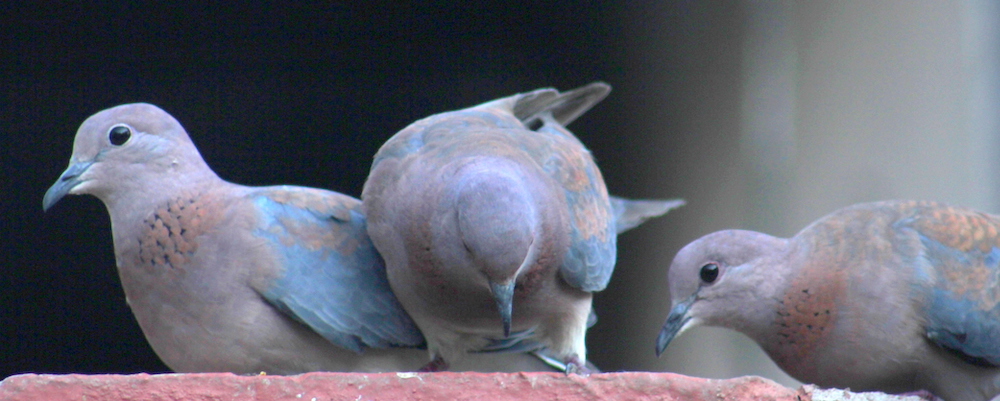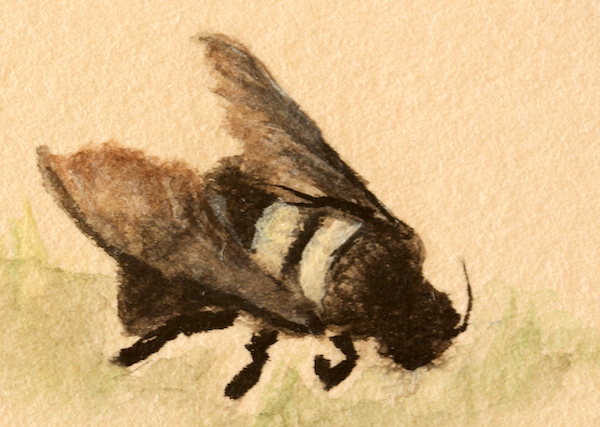Marit Greenwood and her husband live in South Africa. She is an artist who is drawn to contemplative spirituality and is responsible for the photographs and watercolour sketches.
On many mornings, at least thirty laughing doves descend on the feeding table in our garden to staccato-peck the birdseed. One even has a name – Vlerkie (Little Wing) – identified readily by her drooping primary wing feathers. She’s been around for at least six years; we’ve watched her nest in a flimsy crook of the large avocado tree adjacent to the table, watched her mate, watched her companionably hanging around a dying dove.

Cut-throat finches also visit, squealing as they compete for place at the feeders hanging just above the table, accompanied sometimes by a miniature crowd of teeny bronze mannikins which look like wind-up clockwork toys, tails twitching from side to side as they forage under the table, behaving as a single organism with many active beaks, flying off in one corporate swoop of wing at the slightest perceived threat. “TickTocks” is our name for them.
Last autumn we witnessed a praying mantis deposit her eggs and build her egg sac on an ageing wooden stable door, the entrance to the nearby studio. No wonder Jean-Henri Fabre in his Book of Insects refers to her creation (called ootheca) as looking like something a confectioner would whip up! It took her hours.
Incredibly, by chance I saw the babies emerging that spring. Wraithlike; some expending what seemed to be considerable energy to drag their back legs out of the neat nest envelopes.
Thereafter we periodically saw juniors, then teenagers, then young adults, at some distance from the nest. Her offspring? Since we had discovered five other nests elsewhere, who knows?
Between the massive wild basil plants, ebullient irises and unnamed pinky-red-flowering bushy plants, bees and other nectar-seeking insects, including the two-pip policeman butterfly, have options in our garden. Watching the carpenter bee crawl nose first into an iris bloom is as pleasurable as a slow lick on an ice cream cone. Once we saw one crawl feebly over the lawn grass near this garden bed, curl up, and die.


To my astonishment, of an evening I saw a sphinx moth, proboscis extended over a distance of about six centimetres, slurp up the nectar of the spider lily blooms, this lily having front-row status in the bed. (Ah, so that is why the squash plant flowers only bloom at night.) Then too we watched a large darkling beetle labour across twigs and dry leaves in this bed, moving like an ancient armoured military tanker doggedly missioning into enemy territory.
After the mysterious disappearance of a slice of lawn, we learnt that some little creatures that like chewing grass roots were most likely responsible for this mini desert. Weeds with flat, disc-shaped leaves have moved in since. The house sparrows consider this an attractive feeding ground nowadays. Watching them, languid doves sun themselves on the brickwork nearby, wings stretched out over the warmth; ants scurrying on the feathers, vacuuming up little skin irritants that serve as their meal while cleaning up the birds.
Too busy to watch them, the Karoo thrushes attack the lawn, piercing it with their orange beaks for worm, grub or bug. Some delight in bathing in the little plastic tub on the feeding table. Fiercely protective of that water, they can return to it up to eight times, emerging eventually like wet mops, their handsome “facial” features wetted into severe sternness from the constant dipping.
I would like to tell you about the death’s-head hawk moth in the nightshade tree, the mud wasp, solitary bee, and soil-caked garden snail halfway up the wall of the house, and more.
But that will just have to wait, for now, that is.
The Kirby Laing Centre for Public Theology in Cambridge. Charity registered in England and Wales. Charity Number: 1191741
Kirby Laing Centre, The New Mill House, Unit 1, Chesterton Mill, French’s Road, Cambridge, CB4 3NP
© 2022 The Kirby Laing Centre for Public Theology in Cambridge